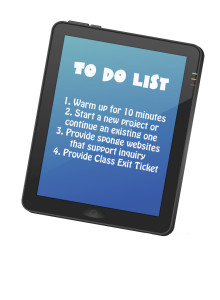 In the past few weeks, I’ve gotten several emails like this from teachers:
In the past few weeks, I’ve gotten several emails like this from teachers:
I am a tech teacher, going on my fifth year in the lab. Each year I plan to be more organized than the last, and most often I revert back to the “way things were.” I’m determined to run the lab just like I think it should be! … Could you please elaborate on how you run your class? I love the idea of having kids work independently, accomplishing to do lists, and working on different projects. You mention this in Volume I, but I want to hear more!
Currently, I see close to 700 students, grades 1-6. I want to break out of the routine (the “you listen, I speak, you do” routine), and your system seems like it would work well. Just hoping you can share some details.
I decided to jot down my typical (as if any planned lesson ever comes out the way it’s written–you know how that goes!) daily lesson. You can tweak it, depending upon the grade you teach. Here goes:
Typical 45-minute Lesson
Each lesson requires about 45 minutes of time, either in one sitting or spread throughout the week. Both are fine and will inform whether you unpack this lesson:
- In the grade-level classroom
- In the school’s tech lab
As you face a room full of eager faces, remember that you are a guide, not an autocrat. Use the Socratic Method—don’t take over the student’s mouse and click for them or type in a web address when they need to learn that skill. Even if it takes longer, guide them to the answer so they aren’t afraid of how they got there. If you’ve been doing this with students since kindergarten, you know it works. In fact, by the end of kindergarten, you saw remarkable results.
When talking with students, always use the correct domain-specific vocabulary. Emphasize it and expect students to understand it.
In general terms, here’s how to run a lesson in the tech lab:
- Students warm up with 10 minutes of typing practice on school keyboarding Some days, youngers work instead on alphabet sites such as Bembo’s Zoo or Starfall Letters (Google for websites).
- If it’s the end of a grading period, use the Scope and Sequence or curriculum map to review which skills have been accomplished.
- If starting a new project, review it first and take questions. If in the middle of one, students use the balance of class to work towards completion. Monitor activities, answer questions, help where needed.
- As often as possible, give younger students enough time on a project to practice and repeat. This redundancy reinforces new skills and mitigates stress.
- Provide age-appropriate ‘sponge activities’ from a topic that ties into class inquiry for students who complete the current project. List websites on a class internet start page. Students know websites on this page can be used during sponge time.
- Class exit ticket might include lining up in arrays, answering a poll posted on the Smartscreen, or simply leaving stations as students found them.
- Cover digital citizenship and problem solving organically when required.
Here’s how to run the lesson in the grade-level classroom:
Take the lesson pieces above and scatter them throughout the week. For example:
- 3 minutes for the class warm-up can be done at the start of Monday or Tuesday
- 10-15 minutes of keyboarding practice can be done any day
- 25-35 minutes for the project can be done any day
If you’re the classroom teacher , watch this video (about half-way through):
How do you teach tech skills authentically in your class? Do you cover critical topics like keyboarding, problem-solving, and digital citizenship?
Jacqui Murray has been teaching K-8 technology for 15 years. She is the editor/author of over a hundred tech ed resources including a K-8 technology curriculum, K-8 keyboard curriculum, K-8 Digital Citizenship curriculum. She is an adjunct professor in tech ed, CSG Master Teacher, webmaster for four blogs, an Amazon Vine Voice book reviewer, Editorial Review Board member for Journal for Computing Teachers, CAEP reviewer, CSTA presentation reviewer, freelance journalist on tech ed topics, and a weekly contributor to TeachHUB. You can find her resources at Structured Learning.




































Love your blog and teacher information. Most appreciated. When did you first start blogging this type of information? http://www.segmation.com
Thanks! Yes, long time ago. As long as I’ve been teaching!